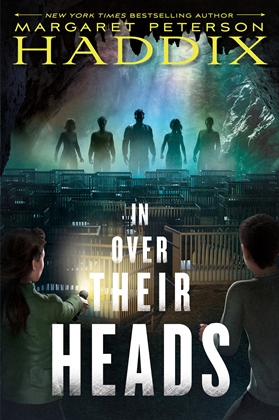In Over Their Heads: Frequently Asked Questions
Note: My answers may contain some spoilers for the book—please don’t read this if you haven’t finished the book!
Why did you tell the story from Ava and Jackson’s perspective, as well as Nick and Eryn’s?
I knew the robot kids would see things very differently than Nick and Eryn, and I thought all four kids’ viewpoints were important to the tale.
Was it hard to switch back and forth between the viewpoints?
Yes! It wasn’t quite as difficult as I thought it was going to be, but I did have to plan things out carefully. The hardest part was balancing Jackson’s perspective when he was so far apart from the other kids. But it was also fun to imagine how completely differently they all interpreted some of the same information, and how differently they saw one another and Lida Mae. You may notice that I did not follow the same order of whose turn it was to speak throughout the book—I didn’t want to restrict the story too much. But I almost succeeded in giving all four of the main characters the same number of chapters. (Ava ended up with one more chapter than Eryn, Nick, and Jackson; poor Lida Mae only got the prologue from her perspective.)
Why does the entire story take place in or near Mammoth Cave?
Because Mammoth Cave is cool.
Okay, that’s only part of the reason. I knew the kids and their parents had to be somewhere off the grid, or else the other robots in the world would instantly know everything that was happening. And of course Lida Mae and her family—and the original efforts to save humanity—all had to exist in a hidden place. I’m sure another huge cave system or remote location could also have worked, but I’ve been to Mammoth Cave the most, and I am fascinated by all the ways humans have used it over the years—at one point, doctors even thought it was a healthier place for people with tuberculosis to live.
(For people already sick with what was often a fatal disease back then, I think it would have been really, really depressing to live in a cave and not see the sun.)
Do you really think robots and humans could ever be seen as equals?
I’m no robotics expert—or robotics ethics expert—so there are a lot of people more qualified to answer this question than I am. But it’s fascinating to think about, and people who are kids now may well be the ones making decisions about robot rights vs, human rights in the not-too-distant future. I did a lot of research when I was working on UNDER THEIR SKIN and IN OVER THEIR HEADS, and it seems like the categories might blur together at a certain point. If, say, someday we treat Alzheimer’s disease with a computer chip in the brain, are the people who can only access their memories electronically more robot or more human? Most of us would probably say that that’s a different situation than putting a device in a human’s chest telling the heart to beat—something that already happens, for heart patients with pacemakers. But is it? Why?
I would like to believe that as technology improves, we will be able to answer these kinds of questions calmly, rationally, and compassionately. But humans don’t even have a great record of treating one another as equals. So it might be a turbulent route to figuring out what’s fair.
Is there going to be a sequel to IN OVER THEIR HEADS?
Probably not. I wanted to leave it to readers’ imagination to think about what might happen next!




Connect with Margaret: